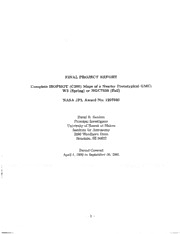
NASA Technical Reports Server (NTRS) 20020034903: Complete ISOPHOT (C200) Maps of a Nearby Prototypical GMC: W3 (Spring) or NGC7538 (Fall) PDF
Preview NASA Technical Reports Server (NTRS) 20020034903: Complete ISOPHOT (C200) Maps of a Nearby Prototypical GMC: W3 (Spring) or NGC7538 (Fall)
FINAL PROJECT REPORT Complete ISOPHOT (C200) Maps of a Nearby Prototypical GMC: W3 (Spring) or NGC7538 (Fall) NASA JPL Award No: 1207030 David B. Sanders Principal Investigator University of Hawaii at Manoa Institute for Astronomy 2680 Woodlawn Drive Honolulu, HI 96822 Period Covered April 1, 1999 to September 30, 2001 Final Report for JPL Contract No. 1207030 1. Brief background of proposed science: We were originally awarded Priority 3 time (_60,000 sec) with ISO to obtain a complete ISOPHOT (PHT32-C200) map of a nearby prototypical giant molecular cloud (GMC). Following the FALL launch and revised estimates for the sensitivity of the ISOPHOT detectors, our program was modified to fit within the time constraints while still carry- ing out the main science requirements. The revised program requested long strip maps of our FALL target (NGC7538) using sequences of PHT37/38/39 observations with LWS observations of the brightest regions. The large number of AOTs required to cover each GMC required that our observations be spread over four separate proposals (PROP_01, PROP_02, PROP_03, PROP_04) which together comprise a single observing program. Our program was executed in early 1997; nearly 50,000 sec of data were obtained, including all of our requested ISOPHOT C200 observations. None of the LWS data were taken. 2. Scientific Results: The primary project goal was the determination of the 135-200 #m luminosity of the NGC7538 GMC, with spatial resolution of _5'. Our secondary goal was to determine the dust temperatures at each position where the photometry is sampled. The ISOPHOT data, as suspected, indeed proved to be critical for understanding the luminosity sources within GMCs due to the fact that the bulk of the luminosity from GMCs is emitted at wavelengths between ,-_80-300 #m. Previous observations which we have obtained, both with IRAS all-sky maps at 12, 25, 60, and 100#m, and more recently with the Submillimeter Common User Bolometer Array (SCUBA) with the JCMT on Mauna Kea at wavelengths of 450#m and 850#m provide information only on the short and long wavelength tails of the true spectral energy distribution (SED). Accuartely cali- brated ISOPHOT maps in the 100-200#m wavelength range allowed us to determine true distribution of luminosity sources within the cloud, and thus to reach a more detailed understanding of the global energy balance in both massive star-forming cores and the apparently more quiesent bulk of the GMC. 3. Publications resulting from this _ant: The results from our ISOPHOT observations were published as part of James Deane's PhD thesis. The Spatial Distribution of Infrared Luminosity and Molecular Gas in Giant Molecular Clouds, Deane, J.R., Ph.D. Thesis, University of Hawaii, (August, 2ooo). -2-
